小学英语方位词电子教案
- 格式:ppt
- 大小:977.50 KB
- 文档页数:26
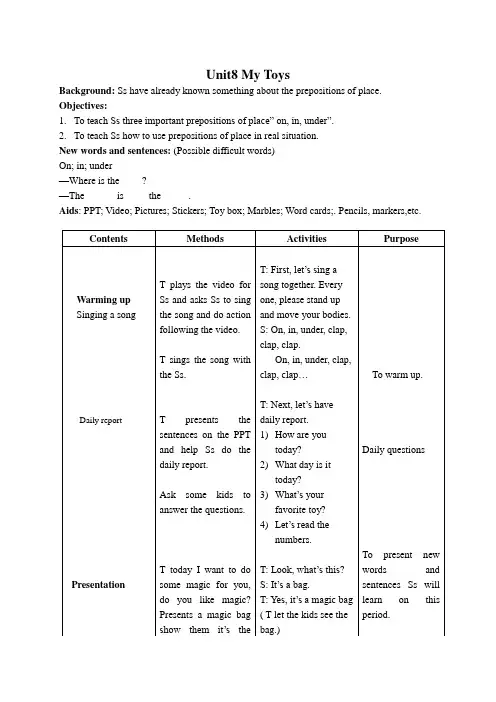
Unit8 My Toys
Background: Ss have already known something about the prepositions of place. Objectives:
1.To teach Ss three important prepositions of place” on, in, under”.
2.To teach Ss how to use prepositions of place in real situation.
New words and sentences: (Possible difficult words)
On; in; under
—Where is the ____?
—The______ is ____ the _____.
Aids: PPT; Video; Pictures; Stickers; Toy box; Marbles; Word cards;. Pencils, markers,etc.
Writing on the board:
Where is the ____?
The ____________ is the ________?
设计思路和理念:
本堂课的主要内容就是孩子对英语中方位介词的理解和学习。
为了给孩子创设更好、更自然流畅的教学情境,课堂一开始老师变的小魔术紧紧地吸引了孩子们的目光,从找泰迪熊开始,逐步深入课堂,并自然而然的引出方位介词的问句和答句。
课堂中采用各种形式的游戏活动来巩固和加强,让孩子在轻松、愉悦的氛围中掌握了课堂上的重难点。

英语教案模板方位(共4篇)第1篇:英语方位(一)in the east 与 on the east的区别1.in the east表示我们生活中和地理位置上的绝对方向。
如:The sun rises in the east and sets in the west.太阳从东边升起,从西边落下。
The Great Wall begins in the east from the Shanghaiguan Pa and ends at the Jiayuguan Pa in the west.长城东起山海关,西至嘉峪关。
2.on the east表示某事物位于另一事物所朝的方向。
这里的方向是相对而言的。
如:China faces the Pacific on the east.中国东临太平洋。
The United States faces the Atlantic on the east and the Pacific on the west.美国东临大西洋,西濒太平洋。
(二)in (to,on,at)the east of1.要表示A在B的东部,即:A在B的范围之内时就用"A is in the east of B",如:Japan is in the east of Asia.日本在亚洲东部。
Italy is in the south of Europe.意大利在欧洲南部。
2.如果A在B的东方,即:A在B的范围之外,且相隔有一定的距离,就用"A lies to the east of B".口语中有时可将to the省去。
如:Japan lies(to the)east of China.日本位于中国东方。
France lies(to the)east of England.法国位于英国东方。
3.如果A在B的东边(侧),即:A与B相邻接。
就用"A is on the east of B".如:Guangdong is on the south of Hunan.广东在湖南南边。

#### 教学目标:1. 通过趣味性的活动,帮助学生理解和掌握基本的方位介词:in, on, under。
2. 培养学生用英语表达空间关系的语言能力。
3. 激发学生对英语学习的兴趣,提高课堂参与度。
#### 教学对象:小学三年级学生#### 教学时间:1课时#### 教学准备:1. 多媒体课件,包含各种物品图片(如桌子、椅子、地板、盒子等)。
2. 方位介词卡片:in, on, under。
3. 小物品(如玩具、小汽车等),用于课堂活动。
4. 彩色粉笔或记号笔。
#### 教学过程:##### 一、热身活动(Warm-up)1. 师生互动:用简单的英语问候和自我介绍,复习已学过的问候语。
2. 游戏环节:“猜猜我在哪里?”教师用英语描述一个物品的位置,学生猜物品在哪里。
##### 二、导入新课(Introduction)1. 展示图片:教师展示一系列图片,引导学生用英语描述物品的位置,如:“The book is on the table.”2. 引入方位介词:在描述过程中,特别强调in, on, under这三个方位介词的使用。
##### 三、新授环节(Presentation)1. 介绍方位介词卡片:逐一展示卡片,让学生听并跟读方位介词。
2. 互动练习:教师手持小物品,提问:“Where is the car? Is it in the box?/Is it on the table?/Is it under the chair?”引导学生回答。
##### 四、实践环节(Practice)1. 小组活动:将学生分成小组,每组发一套方位介词卡片和若干小物品。
2. 每组学生需将小物品放在正确的位置,并用相应的方位介词进行描述。
3. 小组展示:每组派代表展示他们的作品,其他小组进行评价。
##### 五、巩固环节(Consolidation)1. 游戏环节:“方位猜谜”:教师描述一个物品的位置,学生需要找到正确的物品并说出正确的方位介词。
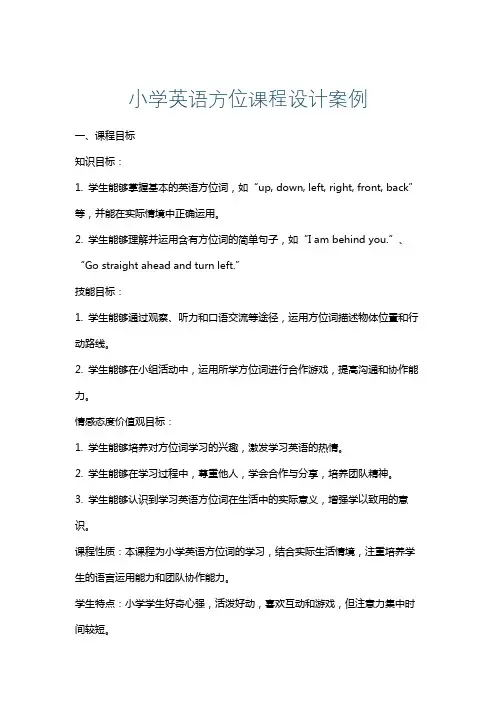
小学英语方位课程设计案例一、课程目标知识目标:1. 学生能够掌握基本的英语方位词,如“up, down, left, right, front, back”等,并能在实际情境中正确运用。
2. 学生能够理解并运用含有方位词的简单句子,如“I am behind you.”、“Go straight ahead and turn left.”技能目标:1. 学生能够通过观察、听力和口语交流等途径,运用方位词描述物体位置和行动路线。
2. 学生能够在小组活动中,运用所学方位词进行合作游戏,提高沟通和协作能力。
情感态度价值观目标:1. 学生能够培养对方位词学习的兴趣,激发学习英语的热情。
2. 学生能够在学习过程中,尊重他人,学会合作与分享,培养团队精神。
3. 学生能够认识到学习英语方位词在生活中的实际意义,增强学以致用的意识。
课程性质:本课程为小学英语方位词的学习,结合实际生活情境,注重培养学生的语言运用能力和团队协作能力。
学生特点:小学学生好奇心强,活泼好动,喜欢互动和游戏,但注意力集中时间较短。
教学要求:课程设计应注重趣味性和互动性,结合生活实际,让学生在实际操作中学习,提高学习效果。
同时,关注学生的个体差异,鼓励每个学生积极参与,充分展示自己。
通过分解课程目标为具体的学习成果,使教学设计和评估更具针对性。
二、教学内容本节课教学内容围绕小学英语方位词展开,依据课程目标,选择以下内容进行组织教学:1. 方位词学习:up, down, left, right, front, back- 教材章节:Unit 2 "Where is it?"- 教学内容:通过图片、动作和实物展示,让学生直观地学习并掌握以上方位词。
2. 方位词在句子中的应用- 教材章节:Unit 2 "Where is it?"- 教学内容:教授并练习含有方位词的简单句子,如"I am behind you."、"Go straight ahead and turn left."3. 实践活动:方位词游戏- 教学内容:设计小组合作游戏,如“寻宝”等,让学生在实际情境中运用所学方位词,提高语言实际运用能力。
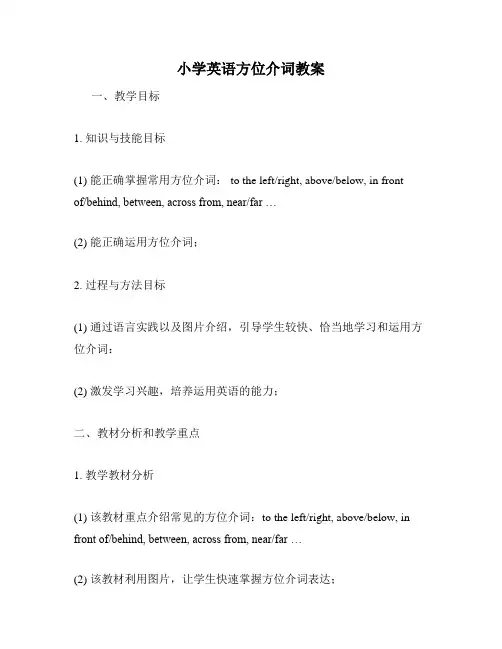
小学英语方位介词教案一、教学目标1. 知识与技能目标(1) 能正确掌握常用方位介词: to the left/right, above/below, in frontof/behind, between, across from, near/far …(2) 能正确运用方位介词;2. 过程与方法目标(1) 通过语言实践以及图片介绍,引导学生较快、恰当地学习和运用方位介词:(2) 激发学习兴趣,培养运用英语的能力;二、教材分析和教学重点1. 教学教材分析(1) 该教材重点介绍常见的方位介词:to the left/right, above/below, in front of/behind, between, across from, near/far …(2) 该教材利用图片,让学生快速掌握方位介词表达;2. 教学重点:(1) 掌握常用方位介词:to the left/right, above/below, in front of/behind, between, across from, near/far …(2) 运用正确的方位介词描述图片相关表达三、教学过程1. 新课导入:(1) 老师向学生介绍今天要学习的方位介词:T: Good morning, everyone. Today we are going to learn a new topic---prepositions of place. Do you know what is a preposition?Ss: A preposition is a word that shows the relationship between other words in a sentence.T: Very good. Now I’m going to show you some pictures to introduce the prepositions of place. Look at this one, can you tell me what preposition do you need to describe this picture?Ss: Above.2. 认识新词:(1) 设计词汇搭配游戏,使学生掌握几个常用的方位介词:T: Now I’m going to give you a game. I will show you the picture and you need to tell me the preposition of the place I'm pointing to.(2) 每个学生挑选以学过的方位介词为角色的卡通角色,对对方的角色或玩具进行描述,发现学过的方位介词并情景运用;T: Now let’s try a new game. Please choose the cartoon character withp reposition you’ve learned, then use the preposition to describe the other’s character or toys.3. 熟练操练:(1) 学生组成小组,在老师的带领下家家围住一个小物品,用学过的方位介词进行描述物品的位置;T: Now please group yourselves and gather round it. And try to use the prepositions to describe the place of the object.(2) 每一个小组一棵树为主题完整描述树的方位;T: I will give each group a tree and you need to work together to describe the place of the tree using the prepositions we have learnt.4. 产出课件:(1) 老师让每组组员手拿信封,用学过的方位介词介绍信封各个部分的位置;T: Now you can use the prepositions to describe the part of the envelope.(2) 如果掌握能力较强,可以在画本上根据老师口头提示画出一颗带着叶子的大树,描述树叶子位置时用学过的方位介词;T: If you master the prepositions, you can draw a big tree with leaves in your drawing book according to my instructions. When you describe the position of the leaves, please use the prepositions we have learnt.五、板书设计常用方位介词:to the left/rightabove/belowin front of/behindbetweenacross from near/far。
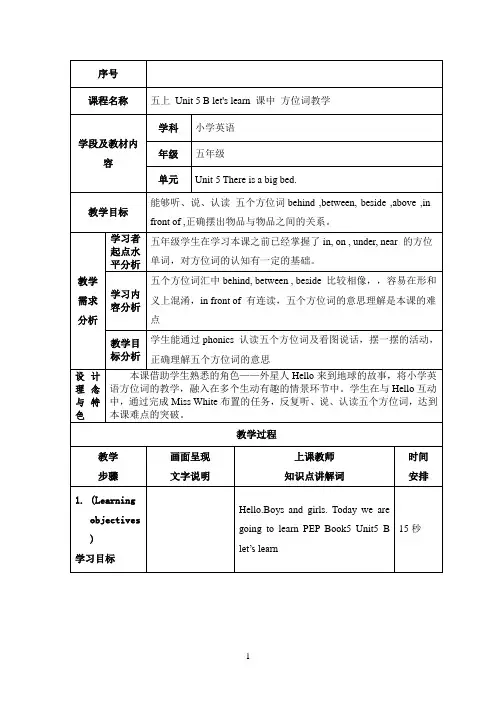
2.(Warm-up)导入It’s early morning. What happen inthe park? Oh! Hello is coming to ourearth again. He is above the trees. Where is he now? Look! He is besidethe house. He is behind the school.Hello is so naughty. Where is he now? He is between the trees. Nowhe is in front of our school. Hello. Friends. Nice to see you again. Let’sgo to play. But miss white says: Boysand girls , if you can pass the tasks,then you can go to play with hello. Hooray!60秒3.(Presentation)呈现与讲解Now , let’s begin . Task 1 Let’slearn . Look at the picture ,Where isthe ball? The ball is in front of thedog. In front of. The ball is in frontof the dog. Where is the ball? It’sbeside the dog. Beside. i..e bike,nine. The ball is beside the dog. Theball is between the dogs, Between,tree, see, Where is theball? It’s behind the dog. behind,kind, find. The ball is abovethe dog. above.love. The ball isabove the dog. Look at this picture, isthe ball above the dog? No, the ballis on the dog’s head. Above and on2分10秒are not the same.After learning , can you read? Let’stry. Above, hehind, between,beside,infront of. Wow, you are great!30秒4.(Practice)操练Let’s continue task2.Look and answer.Where is the photo? It’s between the clock and the window.Whe re is the chair? It’s in front of the desk. Where is the bike?It’s behindthe door. Where is the clock? It’sabove the computer. We also cansay , it’s above the desk.Where is thebed? It’s beside the window.You are wonderful .50秒Task 3.Listen and do . First , youshould prepare a pencil box and a pencil. Are you ready? Go! Put thepencil beside the pencil box.2秒,Areyou right? Put the pencil on thepencil box. Put the pencil in front ofthe pencil box. Put the pencil behindthe pencil box. Put the pencil abovethe pencil box. Put the pencil between the pencil boxes. You are so clever.60秒Who’s bedroom is it? It’s Zhang Peng’s bedroom.It’s small but nice. According to the picture and fill inthe blanks, 5秒.Now let’s check the answer. Hello, friends.Welcome tovisit my room. Look! There is a bikebehind the door. There is a clockabove the desk. There is a photo between the clock and the window. Abed is beside the window. My bluechair is in front of the desk. Do youlike my room ?Are you all right?60秒5.(Summary)小结Miss White says: Boys and girls, allof you did the good job. You can goto play with Hello now. Hooray!Let’sgo. Now they are above the school.Then they are beside the school.Where are they now? I see. They arein front of the school. And haha, theyare behind the tree. So cool! Nowthey are between the trees. Goodbyeboys and girls, Good bye Hello!60秒微反思本课借助学生熟悉的外星人Hello、Miss White等角色,创设生动有趣的情境,进行小学英语方位词的教学,突出本课的教学难点。
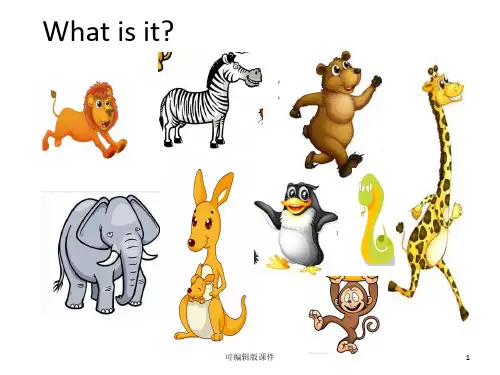
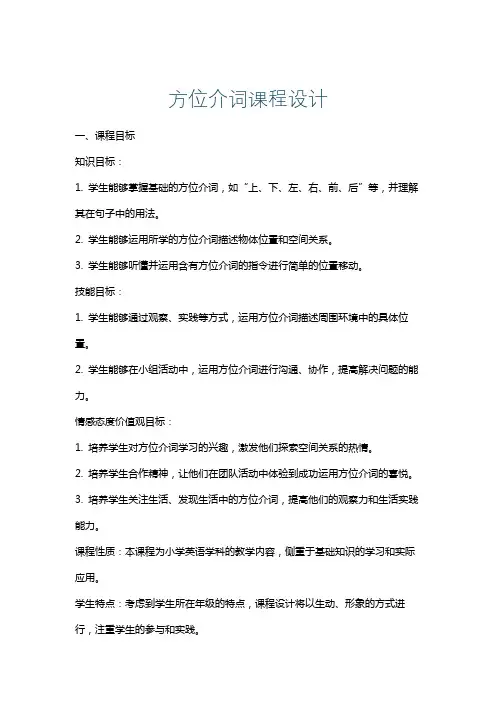
方位介词课程设计一、课程目标知识目标:1. 学生能够掌握基础的方位介词,如“上、下、左、右、前、后”等,并理解其在句子中的用法。
2. 学生能够运用所学的方位介词描述物体位置和空间关系。
3. 学生能够听懂并运用含有方位介词的指令进行简单的位置移动。
技能目标:1. 学生能够通过观察、实践等方式,运用方位介词描述周围环境中的具体位置。
2. 学生能够在小组活动中,运用方位介词进行沟通、协作,提高解决问题的能力。
情感态度价值观目标:1. 培养学生对方位介词学习的兴趣,激发他们探索空间关系的热情。
2. 培养学生合作精神,让他们在团队活动中体验到成功运用方位介词的喜悦。
3. 培养学生关注生活、发现生活中的方位介词,提高他们的观察力和生活实践能力。
课程性质:本课程为小学英语学科的教学内容,侧重于基础知识的学习和实际应用。
学生特点:考虑到学生所在年级的特点,课程设计将以生动、形象的方式进行,注重学生的参与和实践。
教学要求:教师应注重激发学生的学习兴趣,关注学生的个体差异,提供丰富的教学活动,使学生在轻松愉快的氛围中掌握方位介词的知识。
同时,注重将目标分解为具体的学习成果,以便进行后续的教学设计和评估。
二、教学内容本节教学内容以人教版小学《英语》教材中“方位介词”章节为基础,进行以下组织和安排:1. 导入:通过图片展示,引导学生观察并描述图片中的物体位置,引出方位介词的概念。
2. 基础知识学习:- 教学方位介词“上、下、左、右、前、后”等,结合图片进行讲解和示例。
- 通过例句展示方位介词在句子中的用法,让学生模仿并练习。
3. 实践活动:- 组织学生在教室内进行“找一找”游戏,运用方位介词描述物体位置。
- 创设情境,让学生运用方位介词进行对话交流,巩固所学知识。
4. 拓展训练:- 引导学生关注生活中的方位介词,如家庭、学校、公园等场景。
- 通过绘制地图、编写小故事等形式,让学生运用方位介词描述空间关系。
5. 总结与反馈:- 对本节课所学内容进行总结,检查学生对方位介词的掌握情况。
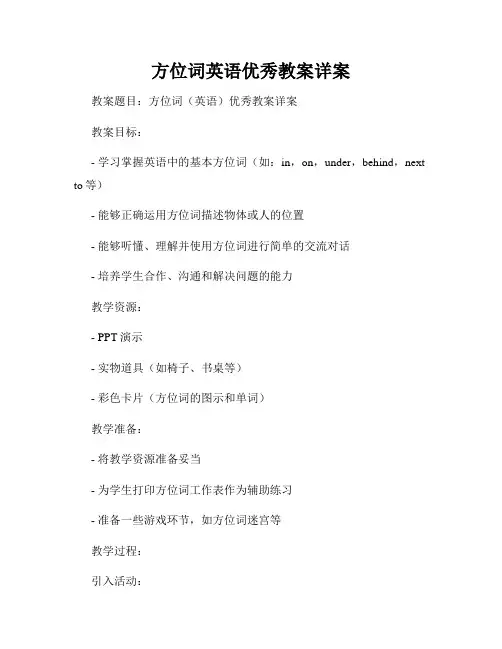
方位词英语优秀教案详案教案题目:方位词(英语)优秀教案详案教案目标:- 学习掌握英语中的基本方位词(如:in,on,under,behind,next to等)- 能够正确运用方位词描述物体或人的位置- 能够听懂、理解并使用方位词进行简单的交流对话- 培养学生合作、沟通和解决问题的能力教学资源:- PPT演示- 实物道具(如椅子、书桌等)- 彩色卡片(方位词的图示和单词)教学准备:- 将教学资源准备妥当- 为学生打印方位词工作表作为辅助练习- 准备一些游戏环节,如方位词迷宫等教学过程:引入活动:1. 展示一张有几个人物或物体的图片,并向学生问问题:“Where is the cat? Is it on the chair or under the table?” 学生回答问题,并引导学生注意关键方位词的使用。
理论学习:2. 通过PPT解释和展示常见方位词的图示和英文单词,并教授其正确发音。
3. 播放英语方位词的歌曲或视频,加深学生对方位词的记忆和理解。
4. 在白板上画一个简单的房间图,并标记物体的位置。
然后与学生一起用英语描述物体的位置,如:The cat is under the table. The book is on the shelf.练习活动:5. 将学生分成小组,每组给出一些实物道具,并要求他们用方位词描述物体的位置。
教师可以给予适当的提示和反馈。
6. 发放方位词工作表给学生,让他们完成练习,并相互分享答案。
教师对学生答案进行评价和指导。
游戏环节:7. 设计方位词迷宫游戏,学生分成小组,从起点走到终点,需要通过正确运用方位词描述迷宫中的物体位置,才能走出迷宫。
8. 进行椅子游戏:教师将教室内的椅子随机摆放,并询问学生:“Where is the red chair? Is it in front of the desk or behind the blackboard?” 学生在听到问题后迅速找到该椅子的位置。
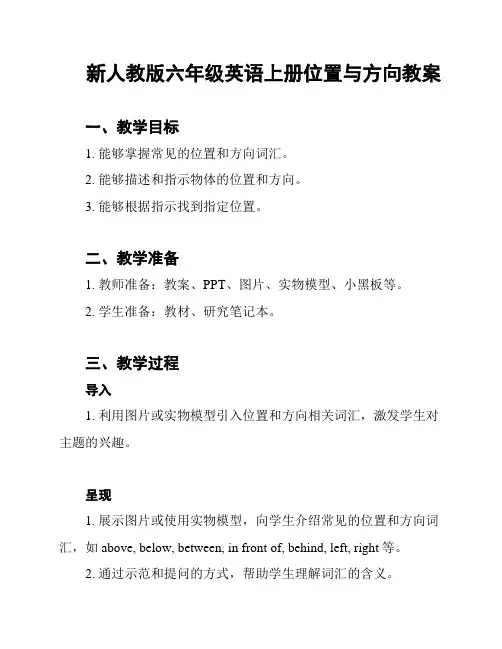
新人教版六年级英语上册位置与方向教案一、教学目标1. 能够掌握常见的位置和方向词汇。
2. 能够描述和指示物体的位置和方向。
3. 能够根据指示找到指定位置。
二、教学准备1. 教师准备:教案、PPT、图片、实物模型、小黑板等。
2. 学生准备:教材、研究笔记本。
三、教学过程导入1. 利用图片或实物模型引入位置和方向相关词汇,激发学生对主题的兴趣。
呈现1. 展示图片或使用实物模型,向学生介绍常见的位置和方向词汇,如above, below, between, in front of, behind, left, right等。
2. 通过示范和提问的方式,帮助学生理解词汇的含义。
操练1. 使用图片、实物或PPT上的场景,向学生提问,让他们描述物体的位置和方向。
2. 学生利用研究笔记本练书写和绘制物体的位置和方向。
3. 让学生两人一组进行练,互相描述和指示物体的位置和方向。
达标检测1. 出示一幅地图,让学生根据描述找到指定位置。
2. 学生个别表演,描述和指示物体的位置和方向。
板书总结1. 将重点词汇和句型整理到小黑板上,供学生复和记忆。
四、作业布置1. 布置相关的练题,要求学生用英语描述和指示物体的位置和方向。
2. 建议学生查看教材相关内容,加深对位置和方向的理解。
五、教学反思本节课通过图片、实物模型和场景的呈现,帮助学生理解和掌握了位置和方向的词汇。
通过操练和达标检测,学生的口语表达和指示能力也得到了提升。
教学中,学生积极参与,课堂气氛活跃,达到了预期的教学效果。
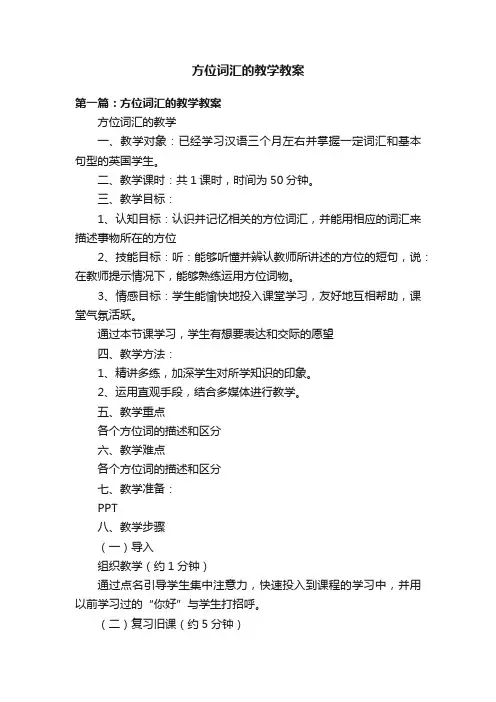
方位词汇的教学教案第一篇:方位词汇的教学教案方位词汇的教学一、教学对象:已经学习汉语三个月左右并掌握一定词汇和基本句型的英国学生。
二、教学课时:共1课时,时间为50分钟。
三、教学目标:1、认知目标:认识并记忆相关的方位词汇,并能用相应的词汇来描述事物所在的方位2、技能目标:听:能够听懂并辨认教师所讲述的方位的短句,说:在教师提示情况下,能够熟练运用方位词物。
3、情感目标:学生能愉快地投入课堂学习,友好地互相帮助,课堂气氛活跃。
通过本节课学习,学生有想要表达和交际的愿望四、教学方法:1、精讲多练,加深学生对所学知识的印象。
2、运用直观手段,结合多媒体进行教学。
五、教学重点各个方位词的描述和区分六、教学难点各个方位词的描述和区分七、教学准备:PPT八、教学步骤(一)导入组织教学(约1分钟)通过点名引导学生集中注意力,快速投入到课程的学习中,并用以前学习过的“你好”与学生打招呼。
(二)复习旧课(约5分钟)(三)讲练新课(约35分钟)1、首先学习新课中的生词教师将生词和生词所代表的含义用图片放在ppt上,方便学生认识拼读。
教师说:“听我读”(手托起示意全体,指指耳朵,表示让学生听,教师范读两遍)。
教师说:“跟我读”(手托起示意全体,指指嘴巴,表示让学生读,教师领读学生跟读两遍)老师领读,让学生跟读。
2、学习新课文教师朗读课文,然后向学生解释其中的含义。
3、重点讲解重点讲解有、在两个词的含义4、给学生图片,让学生描述图片中的方位第二篇:词汇教学教案Teaching plan Student: junior school grade 2 Lesson tape: new words Teaching content: stomachache, headache, toothache Teaching procedures: 1.Draw a body picture on the blackboard;ask them where our stomach is? Repeat “stomach” three times.And write down the word “stomach” on the black board and write down “stomachache” at the same time.Tell them “ache” stand for pain when it adds in the word of our organs.Ask them to repeat the word.2.Ask them where our head is? Repeat “head” three times.And write down the word “head” on the black board and write down “headache” at the same time.Ask them to repeat the word.3.Ask them where our teeth are? Repeat “tooth” three times.And write down the word “tooth” on the black board and write down “toothache” at the same time.Ask them to repeat the word.第三篇:词汇教学教案Unit1 My Classroom Part A Let’s Learn一、教学内容:PEP 小学英语四年级上册Uint1 Part A Let’s learn二、教材分析:PEP 小学英语教材以话题为纲,从内容、形式、方法、插图等方面都以最大限度地激发学生学习的动机和兴趣,以交际功能为主线,兼顾语言结构,逐步引导学生运用英语完成有实际目的语言任务,本教材还注重双向交流的中西方文化知识的渗透,在教学内容中选编了一些适合学生年龄特点和认知能力的中西文化知识。
小学英语方位介词课程设计一、课程目标知识目标:1. 学生能够掌握基本的英语方位介词,如in, on, under, behind, in front of 等。
2. 学生能够运用所学方位介词描述物体位置,理解并执行简单的指令。
3. 学生了解并能够使用含有方位介词的句子,如“Where is the book? It's on the table.”技能目标:1. 学生能够通过听、说、读、写的实践活动,熟练运用方位介词。
2. 学生能够在小组合作中,用英语进行简单的位置描述和交流。
3. 学生能够利用所学知识,解决实际生活中的位置问题。
情感态度价值观目标:1. 学生养成合作学习的习惯,增强团队意识。
2. 学生在英语学习过程中,体验成功,增强自信心,激发学习兴趣。
3. 学生通过学习方位介词,培养空间概念,提高观察力和逻辑思维能力。
分析课程性质、学生特点和教学要求,本课程以小学高年级学生为对象,结合他们好奇心强、活泼好动的特点,设计生动有趣的教学活动。
通过实际操作、互动交流等方式,使学生将所学知识应用于实际情境中,提高英语运用能力,培养正确的情感态度和价值观。
课程目标具体明确,便于教师进行教学设计和评估,确保学生能够达到预期学习成果。
本章节教学内容以人教版小学英语教材中方位介词为主题,结合课程目标,进行以下组织和安排:1. 引入方位介词概念:通过图片展示、实际操作等方式,使学生了解和感知方位介词的基本含义,如in, on, under, behind, in front of等。
2. 教学大纲:a. 方位介词的定义与用法:讲解各个方位介词的含义,并通过实例演示如何运用这些介词描述物体位置。
b. 实践活动:设计听、说、读、写四个方面的实践活动,让学生在实际语境中运用方位介词。
c. 句子练习:结合方位介词,教授如何构造简单的位置描述句子,如“Where is the book? It's on the table.”3. 教学内容安排:a. 第一节课:引入方位介词概念,学习in, on, under三个介词。
小学英语第六册 Lesson Four第一课时一、教学内容:1.复习介词in, on, under, behind, in front of2.学习There be 句型二、教学目标:1.知识目标:理解和掌握There be句型的用法,能使用There be句型介绍或描绘某处有某物。
2.水平目标:1)通过“传话游戏”活动,培养学生听、说、做的水平。
2)使用歌曲Old Macdonald has a farm创设情景,使学生体验过程中学习语言、使用语言。
3.情感目标:学会与同伴合作,学会礼貌待人。
三、教学重、难点:1.能使用There be句型介绍或描绘某处有某物。
2.在与同伴的合作中完成任务。
四、教具准备:歌曲磁带、动物头饰及玩具、水果、蔬菜、图片(房子、树、动物)五、教学步骤:Step 1 Warming-up and revision(热身和复习):1. Sing a song: How are you?(设计意图:唱歌热身,变换问候方式,激发学生兴趣。
)2. 画五个圆形,引出介词 in, on, under, behind, in front of(猜对者或表达准确者得“幸运星”)(设计意图:画圆—>变图型—>复习介词,既是复习,又培养学生的发散思维,更为导入新知做好铺垫。
以“幸运星”作为鼓励机智。
)Step 2 Presentation(新授):1. T: Look, boys and girls, a monkey is coming. He has many questions. Let’s helphim.Ss: OK.M: Hello, I’m monkey. What’s on the table? (重复三遍,并板书。
)T: There is a clock on the table. (重复三遍,并板书。
)2. M: What’s under the chair?Ss: A ball.T: There is a ball under the chair.(学生跟读两遍)(设计意图:创设情景,引出新句型,使学习活动更加真实。
四年级英语方位介词教案Unit4Whereiit?教学目标:1.技能目标:(1)通过学习故事,学生能够正确理解故事内容并朗读课文。
(2)能够运用所学方位词正确描述事物的位置。
2.知识目标:(1)词汇:正确认读名词rockground;动词短语:lookfor疑问词where;方位词on、under、in、behind、infrontof;(2)句型:能够掌握询问和描述事物位置的基本句型,并正确进行描述。
Whereithe……?on……under……It’in……behind……infrontof………3.情感目标:(1)在学习过程中培养学生的合作意识和良好的英语学习习惯。
(2)通过学习故事,培养学生拾到物品应归还失主、朋友需要帮助时要伸出援助之手的意识。
教学重点:理解故事内容,正确朗读课文。
教学难点:正确运用方位介词描述事物的具体位置。
教具准备:CAI、书、图片、单词卡片、自制ppt课件教学过程:(呈现PPT1板书标题)导入语:Children,thicla,let’tudyUnit4together.Whereiit?它在哪?Canyoureadthetitlewithme?学生:Readaftertheteacher:Unit4Whereiit?一、导入:(一)GueinggamePPT2T:Children,nowIhaveariddleforyou.Pleaegue.What’thi?Pleaelook,litenandgue.It’brown.It’yellow.Thequirrellikeitverymuch.S:Look,litenandgue.It’anut.T:Ye,it’anut.Ilikenut.Doyoulikethem?S:Ye.【设计意图】歌曲导入,激发学生学习兴趣,让学生初步了解本节课学习学习内容;猜谜游戏调动学生的参与积极性,引出本课故事主线。
二、新授:(一)故事引入:图片引入PPT3过渡问题:T:Pleaelookatthipicture.Canyoufindanynut?Ye,they’rehere.Somanynutinthetree.Whatotherthingcanyouee?S:lookanday:abird,anake,a frog……T:Verygood,children.Youdidagoodjob.LookatouroldfriendBobby.Heilookingatthenut.Maybehewantanut.L et’enjoythetory“Findinganut”.Beforewatchingit,Ihavetwoquetionforyou:PPT4Quetion1:Whoareinthetory?Quetion2:Wherearethey?【设计意图】通过呈现故事中的图片1,让学生了解故事中的主要事物和故事发生的背景;通过提出两个问题,让学生在观看动画环节能够有侧重点进行观看。